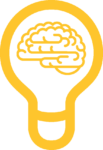
“Wisdom is intuitive reason combined with scientific knowledge.” – Aristotle
When it comes to decision-making, do you tend to apply a more rational or intuitive approach? Research suggests that neither style is inherently more beneficial considering both logical evidence and gut feelings concurrently is what leads to successful strategic conclusions.
To reap the benefits of both systems of thought, let’s first define the two concepts:
Rational Thinking: Utilizes analysis, data and credible sources to make sense of decisions; a logical process where one trusts external sources and concrete facts. Incorporates the aspects of our brains that consider organization, administration and math and science.
Intuitive Thinking: Notices how the brain and body feel when it comes to decision-making; an abstract process where one trusts their internal reactions or gut feelings; unconscious thinking. Pulls from the parts of our brains utilizing emotion, big-picture considerations and belief.
To make connections with the ,Emergenetics Thinking Attributes, intuitive thought often stems from the Social and Conceptual Attributes, or the Divergent part of the brain, whereas rational thought typically comes more naturally to those with Analytical and Structural preferences, or the Convergent part of the brain. Identifying the style you lean toward when assessing options allows you to recognize which strengths to embrace and where to “flex” for optimal decision-making.
Strategize with Rational Thought
If you enjoy puzzles, to-do lists and vetting credible sources, you may gravitate toward a rational approach. Convergent thinkers or those with a Most Preferred Attribute in Analytical or Structural commonly reference studies, statistics, best practices and professionals while prioritizing efficiency and dependability.
Interpreting and organizing information in a data-driven world is a necessary skill. According to a study from Oracle, 97% of business leaders want help from data, yet 78% feel overwhelmed with the abundance of information more than ever before.
If Convergent thinking does not come naturally to you, embrace the value it can bring by introducing these two tactics into your decision-making processes:
 1) Conduct Research and Analyze Data
1) Conduct Research and Analyze Data
Search for evidence as part of your process. Whether this information comes from an accredited professional, source or study, citing your reasoning solidifies solutions and provides credibility for a particular approach. Be mindful and investigate all opinions and recommendations on a matter to further understand the multiple perspectives others may have regarding the situation. You can then select a more nuanced, thoughtful outcome that you feel confident in.
 2) Construct a Pros/Cons List
2) Construct a Pros/Cons List
Weigh the positive and negative outcomes associated with your options to inform your choice. While it may sound simple, picking up a pen and paper the traditional way can reveal the most desired outcome. Start by methodically assessing all the variables impacting a situation including the just-in-case scenarios. Once you know the potential implications of your decision, try using a classic T chart to note the Pros on one side and Cons on the other to confirm the best option.
Hone In on Intuitive Thought
How often do you sense a gut feeling? These sensations are the sudden pangs of awareness that you may feel physically in your body or mentally in your mind. For those who are Divergent thinkers or have a Most Preferred Attribute in Social or Conceptual, these sorts of feelings may occur more often.
According to a study conducted by Project Management Degrees, 62% of top business executives said they often rely on their intuition. This is just one example of the power of trusting your innermost feelings.
To utilize the power of intuition, try implementing these tips to augment strictly rational thought:
 1) Talk with a trusted friend or colleague
1) Talk with a trusted friend or colleague
Connect with a confidant to explore the possibilities. A one-on-one discussion may reveal where your heart truly lies. Enlist the help of a reliable family member, friend or coworker to act as a sounding board for your thoughts and feelings. When evaluating options, you may come to realize an innate solution that benefits the most people. If you are still experiencing uncertainty, consider asking your person of choice what they would do in your shoes to gain a different perspective. Hearing scenarios through someone else’s words can shine light on your own inclinations.
 2) Be curious about your feelings
2) Be curious about your feelings
Pay attention to the physical sensations in your body when you’re given a choice. If you’re having trouble in any given area of your life, imagine that the options in front of you are the only ones available. With other possibilities removed, what feelings arise? Commonly, two appear:
- Openness: a feeling of confidence, lightness or inspiration; the eagerness and excitement to get started on something.
- Contraction: a feeling of heaviness, anxiety or tightness; may feel hunched over, stiff and rigid; the body’s sign of telling you no.
Take note of sudden reactions from your body the next time you choose a course of action. Journaling or utilizing a creative outlet can also serve as a tool to process your thoughts.
Anyone is capable of making better decisions by embracing a holistic approach. When you understand which thinking modality comes naturally to you, you can recognize what steps to take to enhance your process.
I invite you to challenge yourself to embrace one of the tactics above that feels unfamiliar. You will not only enhance your own decision-making. You can also gain a greater understanding and appreciation for people who think differently from you.
Learn how Emergenetics can empower you to embrace cognitive diversity.
Or fill out the form below to speak with one of our employees today.
 Print This Post
Print This Post

